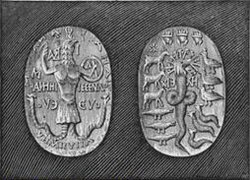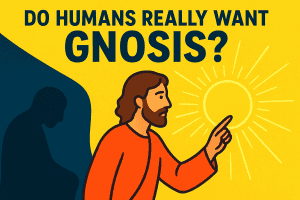Subtitle:
From ancient Gnosticism to Jung’s psychology, Abraxas reveals the terrifying but liberating truth of wholeness beyond good and evil.
Who is Abraxas?
In Gnostic cosmology, Abraxas is a mysterious deity whose name adds up to 365 — symbolizing the totality of the cosmos. Unlike the Demiurge, who binds souls in illusion, Abraxas embodies the Whole: creation and destruction, good and evil, divine and demonic.
Ancient amulets depicted him with:
- 🐓 A rooster’s head — dawn, vigilance, awakening.
- 🧍 A human torso — the bridge between heaven and earth.
- 🐍 Serpent legs — wisdom, eternity, and transformation.
- 🛡️ A whip and shield — power to both protect and command.
For early Gnostics, Abraxas was the god beyond gods, transcending dualities.
Yin, Yang, and the Circle Beyond
The Yin-Yang symbol shows how light and dark swirl together, each containing a seed of its opposite. This represents balance in duality.
But Abraxas is not just balance — he is the circle around the Yin and Yang. He contains and transcends both. He is the wholeness within which all polarities arise.
Where Yin and Yang chase each other, Abraxas is the total field — the container of opposites.
Jung and Abraxas: The Self
In The Seven Sermons to the Dead (1916), Jung describes Abraxas:
“Abraxas is the god whom it is difficult to know. His power is the very greatest, because man perceives in him both good and evil united.”
“God and devil are extreme opposites, but Abraxas is the life that includes both.”
For Jung, Abraxas symbolized the Self — the archetype of totality in the human psyche. Unlike the ego (which wants order, identity, and safety), the Self holds both conscious and unconscious, light and shadow.
In Jung’s psychology:
- Ego = limited, striving for “goodness.”
- Shadow = repressed, dark, and denied.
- Self (Abraxas) = the whole psyche, integrating both.
Encountering Abraxas is terrifying because he reveals that we are not “good” or “evil” — we are both. And only by integrating this truth can we become whole.
Not Safe, But Safer
The Demiurge offers comfort through illusion. “God” and “Devil” offer simplistic categories of good vs bad.
Abraxas is different: he does not comfort, but he tells the truth. He is not safe, but safer — because he destroys illusion and demands wholeness.
Why Abraxas Matters Today
In a divided world of opposites — left vs right, science vs spirit, light vs dark — Abraxas reminds us that true freedom lies not in choosing sides, but in integrating opposites.
Like the Yin-Yang symbol, he shows that wholeness includes both halves. But unlike Yin-Yang, Abraxas also stands as the outer circle — the mystery that contains them all.
Abraxas is not the god of comfort. He is the god of the Self.
📚 Suggested Reading
- The Seven Sermons to the Dead — Carl Jung
- The Secret Teachings of All Ages — Manly P. Hall
- The Gnostic Gospels — Elaine Pagels
- The Nag Hammadi Scriptures — Marvin Meyer (ed.)
🔗 Some Additional UK Links
- The Nag Hammadi Scriptures by Marvin Meyer – available from Eden.co.uk for about £28.92, free UK delivery on orders over £10. eden.co.uk
- The Gnostic Jung: Including Seven Sermons to the Dead (Segal/Jung volume) – available at Routledge & other academic bookshops. routledge.com
Before saving, open your browser’s print dialog and turn off Headers and footers (the title and URL line).
Chrome / Opera / Edge: Menu → Print → uncheck Headers and footers • Firefox: More settings → turn off Print headers and footers • Safari: already clean


